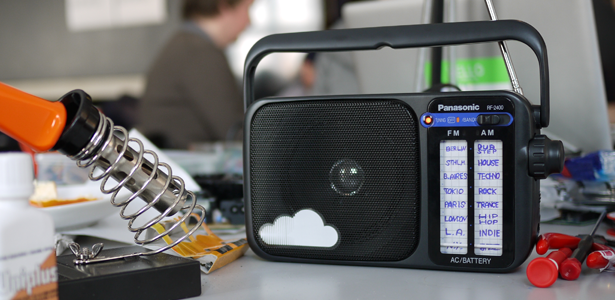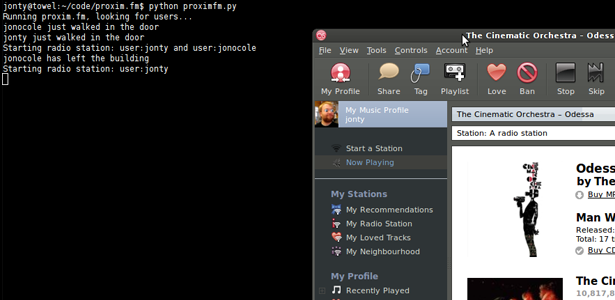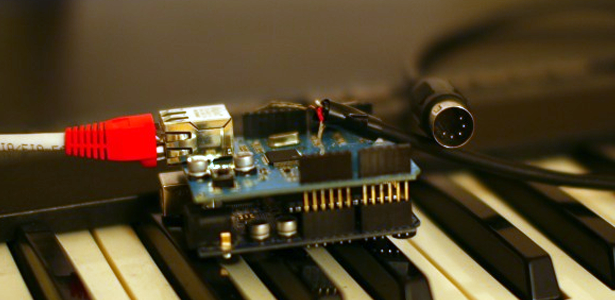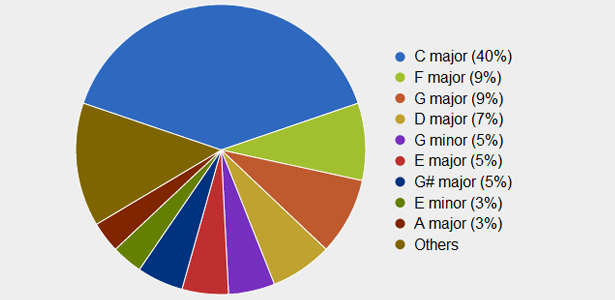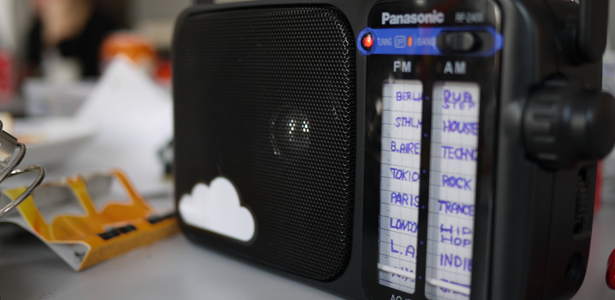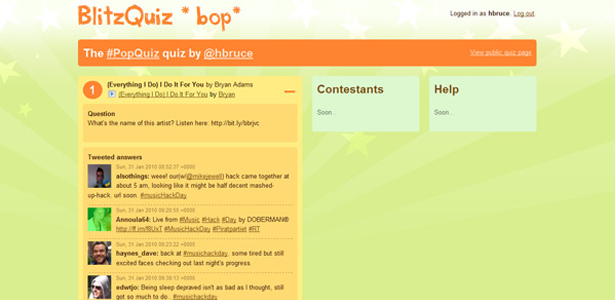What did you do last weekend? Cleaned the house? Watched some football? Had a few friends over? In Stockholm, a group of coders were far too busy for any of that. Instead, they hunkered down and built the future of music at Stockholm Music Hack Day.
The event, which was organized by a trio of likeminded digital music fans - Mattias Arrelid, Henrik Berggren and Dave Haynes, was sponsored by Doberman, Sony Ericsson, Spotify, Vitamin Well, PlusFourSix and Pacemaker, and set the goal of building the next generation of music applications. More than 31 hacks were built at the event, ranging from a Spotify client for the iPad to a spidery metal frame that turns songs into drawings while you listen to them. Here's five of our favourites.
ProximRadio
This is an elegant bit of software that combines the tastes of everyone present in an area into a radio station. It identifies people and their favourite songs by their Bluetooth device's name - you set it to "lfm-username", substituting username for your Last.fm username. Alternatively, you can register Bluetooth MAC addresses to identify people.
Then it'll happily sit there, aware of whoever's nearby, and play songs that they like. When a person leaves, their songs are pulled from the station. When someone new arrives, their songs get added. It can be run through the regular Last.fm client, or through a dedicated application of its own.
Twitter MIDI
Fancy turning 140 characters into 30 notes? Call it micro-composition if you like. One programmer has tweaked a device called an Arduino to generate music based on the content of Tweets.
The diminutive Arduino device - which is a tiny, easily programmable, open-source embedded system on a circuit board - was popular with the crowd at Hack Day. Using the Twitter API, the LAMP software bundle, and an Arduino with an ethernet port, Bertrand Gondouin built a box that will put together a stream of MIDI notes. A web interface can limit that stream to just particular users, or particular hashtags.
Then, you can plug the device into a keyboard or other MIDI-compatible player, and it'll generate random tunes from the content of people's messages. You can even compose yourself, but remember that 140 character limit!
HacKey
What's your favourite musical key? F# minor? Bb major? You might be surprised to find that it's probably not. HacKey delves deep into your Last.fm musical history and then analyses the songs it finds to determine exactly what the most common key you listen to is.
The app - which can be tried online - crawls your top 50 tracks ever, your top 50 tracks of the last six months, your last 50 tracks that you marked as "loved", and then removes the duplicates, before offering you a pie chart of the most common keys. It'll also offer a breakdown of whether you prefer tracks in a major or minor key.
In reality, you're actually determining your favourite bands' favourite key here, rather than your own. Some less imaginative acts stick to the easy ones, like C major, which is the first scale that everyone learns at school - just the white notes on the piano.
Radio Free Hackday
Not all of the mods were limited to software. A pair of hackers named Simon Hohberg and Robert Böhnke took an FM radio (specifically a Panasonic RF-2400), ripped out the guts, and turned it into a more futuristic music player instead.
Again using an Arduino, the pair removed the aerial and altered the station selection display so that it displays a list of cities and a list of genres. Moving the dial allows the listener to choose between music being played in different cities, and music of different genres, streamed from the web via SoundCloud and Citysounds.fm.
Blitzquiz
Lastly, Blitzquiz is a reinvention of the traditional pub-based music quiz. It allows you to turn a playlist of songs into a series of questions on Twitter, with the ability for a quizmaster to set specific puzzlers and choose a hashtag for responses.
The questions will then get tweeted out along with a link to a song page that displays no information about the song in question. Incoming answers are then displayed next to the question, and the quizmaster can pick the first, or best. Individual users are placed in a scoresheet, and may the best man, or woman, win.
A few more
That's just a selection of the impressive hacks on offer in Stockholm. If you're interested further, we'd suggest checking out Amie, Explorify, All In My Box, and the AlbexOne. There's a full listing of all the hacks on the Music Hack Day website.
Spotify were in attendance, too, with a couple of the service's coders making a concerts listing tab for the desktop client, which we'd love to see appear in the real app. Unfortunately, the company rained on that parade, saying: "No plans for concert listings for now - this was basically a bit of hacking fun - but it does show how much potential we have to expand the service further".
The Hack Day, which has visited London, Boston, Berlin and Amsterdam in the past, will be making a return to Britain soon. Simultaneous events in Manchester and London are planned. We'll bring you more on that when we hear it.

